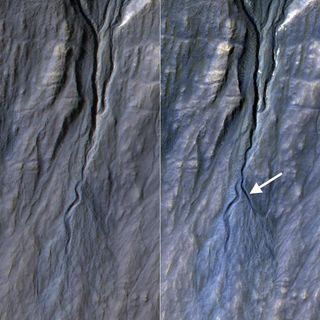
A NASA spacecraft has spotted a big gully on Mars, a feature that appears to have formed only within the last three years.
The powerful HiRISE camera on NASA's Mars Reconnaissance Orbiter (MRO) imaged the channel, which is found on the slope of a crater wall in the Red Planet's mid-southern latitudes, on May 25, 2013. The feature was not present in HiRISE photos of the area taken on Nov. 5, 2010. NASA unveiled the image on Wednesday (March 19).
"The dates of the images are more than a full Martian year apart, so the observations did not pin down the Martian season of the activity at this site," officials wrote in a description of the gully image on Wednesday.
But, they added, "before-and-after HiRISE pairs of similar activity at other sites demonstrate that this type of activity generally occurs in winter, at temperatures so cold that carbon dioxide, rather than water, is likely to play the key role."
However, MRO has observed other Martian features that do seem associated with liquid water — dark streaks known as recurring slope lineae.
RSL lines snake down crater walls and other slopes during warm weather on the Red Planet, and some researchers think they're caused by briny water that contains an iron-based antifreeze. Direct evidence of flowing water at RSL sites, however, remains elusive.

Ancient Mars was much more hospitable to life. For example, NASA's Curiosity rover discovered an ancient lake-and-stream system near its Red Planet landing site that could have supported microbial life billions of years ago.
Get the Space.com Newsletter
Breaking space news, the latest updates on rocket launches, skywatching events and more!
Follow Mike Wall on Twitter @michaeldwall and Google+. Follow us @Spacedotcom, Facebook or Google+. Originally published on Space.com.
Join our Space Forums to keep talking space on the latest missions, night sky and more! And if you have a news tip, correction or comment, let us know at: community@space.com.

Michael Wall is a Senior Space Writer with Space.com and joined the team in 2010. He primarily covers exoplanets, spaceflight and military space, but has been known to dabble in the space art beat. His book about the search for alien life, "Out There," was published on Nov. 13, 2018. Before becoming a science writer, Michael worked as a herpetologist and wildlife biologist. He has a Ph.D. in evolutionary biology from the University of Sydney, Australia, a bachelor's degree from the University of Arizona, and a graduate certificate in science writing from the University of California, Santa Cruz. To find out what his latest project is, you can follow Michael on Twitter.
